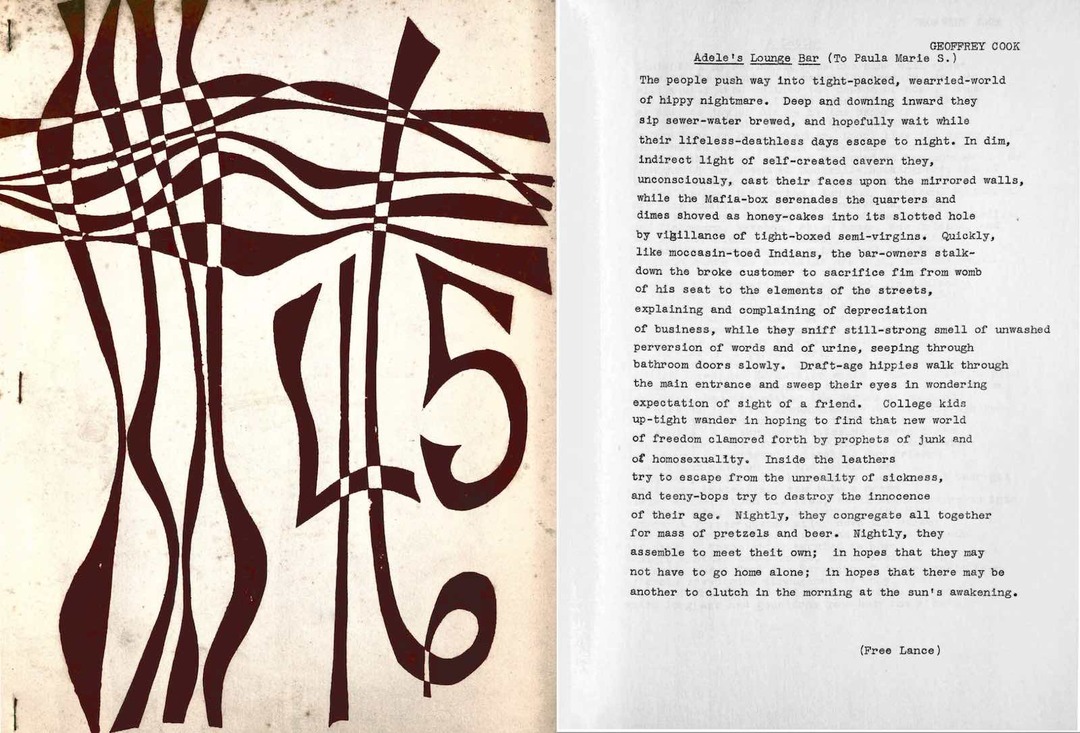
For a short time, a small and humble lounge served as a home for a diverse assortment of people to enjoy each other's company, write poetry, organize activism, and sometimes seek a higher level of consciousness. But surrounding institutions did all in their power to close it down.
Travel back in time to the sixties, and the epicenter of Cleveland’s counterculture scene may well have been 11605 Euclid Avenue, where a small and humble bar was nestled in an ordinary storefront built in front of a turreted Victorian rooming house on the north side of the street between East 115th and 116th Streets. There, one could find an inclusive atmosphere that hosted patrons of many backgrounds and worldviews, a place where Marty and Sam would welcome their patrons with a pint of beer. This little gathering place was Adele’s Lounge Bar, which opened in 1954 in a commercial building that also housed L. Schwartz Antique Shop next door.
One faithful patron, Paul Hilcoff, recalls, “It was a long, fairly narrow space. When you entered from the street, the bar was along the wall on the right. An aisle ran behind the bar and the remaining space was filled with wooden tables. I'm fairly sure there were no booths…. By evening on most days, it was crowded, and there was a perceptible buzz in the air. On weekend nights you'd be lucky to squeeze in there at all, let alone get a table. Lighting was typical barroom-dim, but adequate to pick out faces at the other end of the room… just the usual stale-beer-and-cigarette-smoke background radiation that always permeated well-attended bars.” Yet there was something more important than appearances at Adele’s—the atmosphere and culture it created.
Adele’s is remembered for its diverse clientele, as it was home to bikers, college kids, poets, artists, musicians, hippies, members of the LGBTQ community, interracial couples, and the not-so-occasional high schooler. Hilcoff describes what made Adele’s important to its former patrons: “One of the chief attractions of Adele's, at least from my perspective, was that it was a place where outsiders and misfits could feel comfortable. This atmosphere had already been established by the time I started going there.” But by being home to so many diverse patrons, Adele's caught the attention of University Circle institutional leaders and the Cleveland and Circle police forces, who increasingly disliked the unpredictability and sometimes disorder along Euclid Avenue.
Adele’s peaceful bliss and coexistence within its own community would soon come to end. In the years after its formation in 1957, the University Circle Development Foundation (UCDF) set its sights on de-urbanizing the Circle as well as discouraging establishments and crowds that it believed would be undesirable for the community. Unfortunately, in its view, Adele's Lounge Bar and other popular hangouts along Euclid Avenue fit this description.
As a home to countercultural ideas, Adele’s saw a lot of activism being conducted underneath its roof. Adele’s was also known as one of the few inclusive bars that were friendly toward LGBTQ people, which troubled a lot of traditionalists. In addition, Adele’s was home to underground activist and post-Beat poet d. a. levy, who infamously ran multiple periodicals such as Buddhist Third Class Junkmail Oracle and Marrahwanna Quarterly. Institutional leaders had no room for places like Adele’s in their new plans for the Circle.
Adele’s had a darker side that made it easier for its antagonizers to prey upon it. The culture of Adele's was not so different from the counterculture sweeping the rest of the country. Adele’s, neatly located near Case Tech and Western Reserve University, attracted hordes of young people, many of them from nearby colleges or the Heights suburbs, and some of them engaged in illicit drug use or consumed alcohol under age. By 1966 the use of marijuana, LSD, and other drugs started to catch the attention of the community and law enforcement. Some accounts suggest that dealers sold drugs to adolescents not only outside of the lounge but in it as well. There were also multiple accounts of alcohol being served to minors in the establishment. With violations of this nature, Adele’s soon found itself in the court systems.
The way to permanently shut down Adele’s Lounge Bar seemed to be through inflicting harsh punishments for liquor violations. Throughout its remaining years, Adele’s would spend a great amount of time temporarily closed or operating without a liquor license. Tragically, on February 3, 1969, a fire broke out in the early morning hours, leaving Adele’s completely destroyed and condemned by the city. Authorities blamed an arsonist for the fire, but the destruction of the business would go unpunished. Finally, then, fire accomplished what heavy policing and litigation could not—forcing Adele’s to close for good.
Though some in the media derided it as a haven for “alcoholics and LSD freaks,” Adele’s and similar establishments nearby served as oases for poets, musicians, and activists. And, as one article stated, Adele’s had been “perhaps the only place where an interracial couple wouldn’t feel watched, or where people could talk about socialism or the Bomb without being harassed.” Despite the backlash that Adele’s stirred, its community seemed to look back fondly on the decade of peace, love, and drugs when Adele’s was the heart of countercultural Cleveland.
Images









